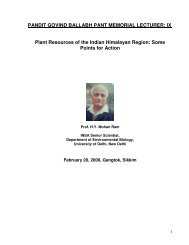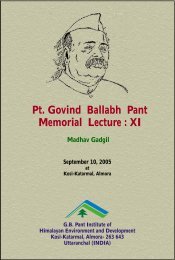Pandit Govind Ballabh Pant Memorial Lecture: II
Pandit Govind Ballabh Pant Memorial Lecture: II
Pandit Govind Ballabh Pant Memorial Lecture: II
Create successful ePaper yourself
Turn your PDF publications into a flip-book with our unique Google optimized e-Paper software.
species are Cedrus deodara, Picea smithiana, and Abies pindrow. Associated<br />
oaks are Quercus incana, Q. semecarpifolia. Other trees found are, Cedrela<br />
serrata, Lyonia ovalifolia , Rohodendron arboreum, Betula alnoides, Carpinus<br />
viminea, Acer cacsium, Fraxinus micrantha, acer pictum, Pyrus lanata, and<br />
Prunus cornuta. Common shrubs found are Pyrus pashia, Berberis lycium,<br />
Dfesmodium tiliae folum, Cotoneaster bacillaris, Rubus ellipticus, Rhamnus<br />
pupurea, Litsaea umbrosa, Rosa macrophylla, Strobilanthes wallichii, Melisoma<br />
dilleniaefloia, Roasa servicea, Vibrunum cotinifolum and Rubus niveus.<br />
The ground cover is constituted by Thalictrum foliolosum, Galium aparine,<br />
Fragaria nubiocola, Viola canescens, Senecio nudicaulis, Valerianan wallichii,<br />
Podophylum emodi, Polygonum vericullatum. Some of the common climbers are<br />
Clematis montana and Vitis himalayana.<br />
Himalayan Dry Temperate: The most important component in this forest type is<br />
Cedrus deodara which occupies belts ranging from 2000 to 2500m- where it<br />
occurs almost in pure formations. However, in the lower altitudes it may either be<br />
raplaced or be mixed with Pinus roxburghii. In the higher reaches Cedrus<br />
deodara is either mixed or replaced by Abies pindrow and Picea smithiana. In<br />
this zone, the broad leaved element is Quercus dilatata, Ulmus wallichinana,<br />
Corylus colurna, Acer caesium and Populus ciliata. Important shrubs of this<br />
forest types are Berberis lycium, Indigofera geradiana Desmodium tiliaefloum,<br />
Spireaea lindleyana, Rhus punjabensis, and Skimmia laureola. The important<br />
herbaceous element is Plectranthus rugosus, Salvaia glutinosa Cannabis sativa<br />
and Fragaria vesca.<br />
Subalpine Forests: These are located between temperate forests and touch the<br />
tree line. This zone extends from 2500 to 3800,. The tree component is Betula<br />
utilis associated with sparse and stunted Abies pindrow.<br />
The understorey is formed by Rhododendron campanulatum, R. lepidotum, R.<br />
anthopogon, Pyrus foliolosa, Sorbus aucuparia, Salix wallichiana, Juniperus<br />
recurva, Lonicera parvifolia, Viburnum nervosum and Rosa sericea.<br />
The herbaceous component is Polygonum vaccinifolum, Potentialla fructicosa,<br />
Primula denticulata, Astragalus oxydon, and Ribes rubrum.<br />
Alpine Pastures and Scrub: These follow the treeline and are composed of<br />
green grassy meadows and pastures during the hot summer season but remain<br />
under snow for the rest of the period. These are found in the high mountain areas<br />
at an altitude of 3500 m, and above. Two sub-types are recognizable:<br />
Moist Alpine Scrub: This occurs above the tree line at 3600m and extends upto<br />
4900m. There are stunted woods alternating with meadows. The scrub consists<br />
of juniperus squamata, j.recurva, j.macropoda and Rhododendron anthopogon.<br />
The herbaceous component is rich and there are many species belonging to the<br />
genera Gentiana, Saxifraga, Corydalis, Rumex, Cardamine Thymus, Aster, Viola,<br />
Campanula, Fritillaria, and Epilobium. The commonly found grasses are<br />
Agropyron spp., Bromus asper and Poa annua. Alpine Scrub: This type of<br />
vegetation occurs at the same altitude as that of the Moist Alpine Scrub.<br />
However, the vegetation is often xerophytic with thorny bushes and grass cover.<br />
13











